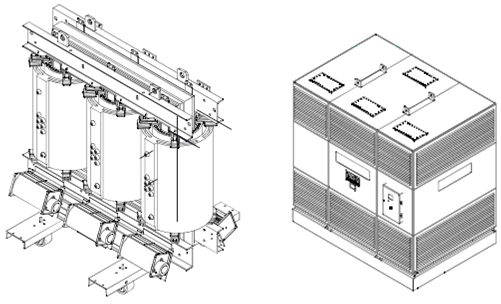
If you wonder how I get my articles published, well it’s easy as ABC cause I just propose an article by mail to the moderator team and after a quick review, they publish it :) So do not hesitate. The more the merrier!
Introduction
Generally, specifying dry type transformer is same as specifying oil transformer. Yet, as dry type transformer is usually used in indoor and when apparent risk exist, there are some specifications we should consider.
According to IEC60076, dry type transformer subject to climatic, environmental, and fire behaviour class (C/E/F) classes. You also need to specify whether you want to install your dry type transformer with or without enclosure. If you want to install with enclosure, don’t forget to specify Index of Protection (IP) rating.
Climatic, environmental, and fire behaviour classes
IEC 60076 state the classification of climatic, environmental, and behaviour for transformer as follow [1]:
Climatic classes
There are two climatic classes:
- Class C1: The transformer is able to operate at ambient temperature not below-50 C but maybe exposed during storage and transport down to -250 C.
- Class C2: The transformer is able to operate, storage, and transport at ambient temperature down to -250 C.
Special test is needed to confirm this specification.
Environmental Classes
This classes define the environmental specification in terms of pollution, humidity, condensation, and ambient temperature.
- Class E0: No condensation and pollution occurs. This condition is usually achieved when the room is clean and dry.
- Class E1: Occasional condensation occurs on the transformer. Restricted pollution is possible.
- Class E2: Both repeated condensation and heavy pollution occurs.
Special test is needed to confirm E1 or E2 specification.
Fire Behaviour Classes
- Class F0: No apparent fire risk.
- Class F1: Apparent fire hazard is subjected.
Both emission of toxic substances and smoke shall be minimised.
Special test is needed to confirm F1 or specification.
You simply specify your dry type transformer based on your C/E/F consideration. Example: C1/E1/F0

Figure 1. Dry type transformer
Index of Protection (IP) Specification of Dry Type Transformer’s Enclosure
The enclosure provide prevention from small object and animals to enter the transformer body. Hence, it is paramount to specify proper IP of the enclosure. The IP specification depends on your environmental condition.
A standard manufacturer may give you IP 21 enclosure for standard clean and dry room condition. But if you think water and dust can slip inside your electrical room, IP 42 enclosure may be specified.
Surge Arrester
Several studies have shown the possibility of dry type transformer failure due to vacuum circuit breaker induced switching transient. Dry type transformer has lower lightning impulse withstand voltage hence it is more vulnerable to switching voltage than oil transformer.
To overcome this situation it is recommended to install surge arrester in high voltage side of a transformer after rigorous evaluation has been done.
Transformer Installation
As dry type transformer is used in indoor installation, the minimum clearance between the transformer and surrounding equipment should be considered for safety precaution. The minimum clearance of transformer equipment is described in IEC 60076-3.
If you install the transformer inside air conditioning electrical room, you have to preserve the temperature and check the air conditioner regularly. If air conditioner does not work properly, the moisture can develop inside the enclosure and allow damage caused by short circuit.
References
[1] “IEC 60076-11:2004 Power transformers – Part 11: Dry-type transformers,” in IEC 60076-11:2004 Power transformers, IEC, 2004, p. 75.
Thanks for reading,
Steven Mill.
What’s your impressions on this content?
Is it oil or something else, used for cooling purpose?